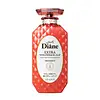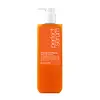Moist Diane Perfect Beauty Extra Volume & Scalp Treatment Versus Mise En Scène Perfect Serum Conditioner
What's inside
What's inside
 Key Ingredients
Key Ingredients

 Benefits
Benefits

 Concerns
Concerns

 Ingredients Side-by-side
Ingredients Side-by-side

Water
Skin ConditioningCetearyl Alcohol
EmollientEthylhexyl Palmitate
EmollientAsparagopsis Armata Extract
Skin ProtectingPropanediol
SolventGamma-Docosalactone
Skin ConditioningQuaternium-33
Glucose
HumectantButylene Glycol
HumectantGlucosyl Hesperidin
HumectantSorbitol
HumectantHydrolyzed Rice Protein
Skin ConditioningPrunus Domestica Seed Extract
EmollientGlycerylamidoethyl Methacrylate/Stearyl Methacrylate Copolymer
HumectantAscophyllum Nodosum Extract
Skin ConditioningSodium Hyaluronate
HumectantKeratin
Skin ConditioningPisum Sativum Sprout Extract
Skin ConditioningChamomilla Recutita Flower Extract
MaskingSpiraea Ulmaria Flower Extract
Skin ConditioningIsomalt
HumectantPolyquaternium-10
Polyquaternium-7
Hydrolyzed Collagen
EmollientHydrolyzed Silk
HumectantPCA Ethyl Cocoyl Arginate
MoisturisingAmodimethicone
Biotin
AntiseborrhoeicPouteria Sapota Seed Oil
EmollientSclerocarya Birrea Seed Oil
HumectantTheobroma Grandiflorum Seed Butter
Skin ConditioningMangifera Indica Seed Oil
EmollientPhytosteryl/Octyldodecyl Lauroyl Glutamate
Skin ConditioningUbiquinone
AntioxidantGlycine Soja Sterols
EmollientCeramide Ng
Skin ConditioningArgania Spinosa Kernel Oil
EmollientCeramide Ag
HumectantCeramide NP
Skin ConditioningCeramide AP
Skin ConditioningCeramide EOP
Skin ConditioningBis-Behenyl/Isostearyl/Phytosteryl Dimer Dilinoleyl Dimer Dilinoleate
EmollientChenopodium Quinoa Seed Oil
EmollientCarapa Guaianensis Seed Oil
Skin ConditioningAdansonia Digitata Seed Oil
EmollientDimethicone
EmollientSodium Lactate
Buffering1,2-Hexanediol
Skin ConditioningCholesterol
EmollientSalicylic Acid
MaskingO-Cymen-5-Ol
AntimicrobialGlyceryl Tri-Hydrogenated Rosinate
EmollientHydrogenated Lecithin
EmulsifyingPolyglyceryl-10 Laurate
Skin ConditioningSteartrimonium Chloride
PreservativeCetrimonium Chloride
AntimicrobialDicocodimonium Chloride
EmulsifyingQuaternium-18
Behentrimonium Chloride
PreservativeIsopropyl Alcohol
SolventGlycerin
HumectantPropylene Glycol
HumectantLactic Acid
BufferingTocopherol
AntioxidantDisodium EDTA
Phenoxyethanol
PreservativeParfum
MaskingCaramel
Cosmetic ColorantWater, Cetearyl Alcohol, Ethylhexyl Palmitate, Asparagopsis Armata Extract, Propanediol, Gamma-Docosalactone, Quaternium-33, Glucose, Butylene Glycol, Glucosyl Hesperidin, Sorbitol, Hydrolyzed Rice Protein, Prunus Domestica Seed Extract, Glycerylamidoethyl Methacrylate/Stearyl Methacrylate Copolymer, Ascophyllum Nodosum Extract, Sodium Hyaluronate, Keratin, Pisum Sativum Sprout Extract, Chamomilla Recutita Flower Extract, Spiraea Ulmaria Flower Extract, Isomalt, Polyquaternium-10, Polyquaternium-7, Hydrolyzed Collagen, Hydrolyzed Silk, PCA Ethyl Cocoyl Arginate, Amodimethicone, Biotin, Pouteria Sapota Seed Oil, Sclerocarya Birrea Seed Oil, Theobroma Grandiflorum Seed Butter, Mangifera Indica Seed Oil, Phytosteryl/Octyldodecyl Lauroyl Glutamate, Ubiquinone, Glycine Soja Sterols, Ceramide Ng, Argania Spinosa Kernel Oil, Ceramide Ag, Ceramide NP, Ceramide AP, Ceramide EOP, Bis-Behenyl/Isostearyl/Phytosteryl Dimer Dilinoleyl Dimer Dilinoleate, Chenopodium Quinoa Seed Oil, Carapa Guaianensis Seed Oil, Adansonia Digitata Seed Oil, Dimethicone, Sodium Lactate, 1,2-Hexanediol, Cholesterol, Salicylic Acid, O-Cymen-5-Ol, Glyceryl Tri-Hydrogenated Rosinate, Hydrogenated Lecithin, Polyglyceryl-10 Laurate, Steartrimonium Chloride, Cetrimonium Chloride, Dicocodimonium Chloride, Quaternium-18, Behentrimonium Chloride, Isopropyl Alcohol, Glycerin, Propylene Glycol, Lactic Acid, Tocopherol, Disodium EDTA, Phenoxyethanol, Parfum, Caramel
Water
Skin ConditioningGlycerin
HumectantDipropylene Glycol
HumectantCetyl Alcohol
EmollientStearyl Alcohol
EmollientDimethicone
EmollientBehentrimonium Chloride
PreservativeIsopropyl Alcohol
SolventParfum
MaskingHydroxyethylcellulose
Emulsion StabilisingEthylhexylglycerin
Skin ConditioningDisodium EDTA
Hc Yellow No. 4
CI 19140
Cosmetic ColorantTocopherol
AntioxidantArgania Spinosa Kernel Oil
EmollientAbies Alba Seed Oil
AntimicrobialOlea Europaea Fruit Oil
MaskingSimmondsia Chinensis Seed Oil
EmollientCamellia Seed Oil
Cocos Nucifera Oil
MaskingCI 17200
Cosmetic ColorantBlue 1 Lake
Cosmetic ColorantCoco-Caprylate/Caprate
EmollientSclerocarya Birrea Seed Oil
HumectantGlycolipids
Skin ConditioningWater, Glycerin, Dipropylene Glycol, Cetyl Alcohol, Stearyl Alcohol, Dimethicone, Behentrimonium Chloride, Isopropyl Alcohol, Parfum, Hydroxyethylcellulose, Ethylhexylglycerin, Disodium EDTA, Hc Yellow No. 4, CI 19140, Tocopherol, Argania Spinosa Kernel Oil, Abies Alba Seed Oil, Olea Europaea Fruit Oil, Simmondsia Chinensis Seed Oil, Camellia Seed Oil, Cocos Nucifera Oil, CI 17200, Blue 1 Lake, Coco-Caprylate/Caprate, Sclerocarya Birrea Seed Oil, Glycolipids
Alternatives
Ingredients Explained
These ingredients are found in both products.
Ingredients higher up in an ingredient list are typically present in a larger amount.
You may know this ingredient as argan oil. Argan Oil has antioxidant, hydrating, and soothing properties.
Studies have shown argan oil can help fight again radical damage from the sun. This makes it effective at preventing hyperpigmentation.
Large amounts of vitamin E found in argan oil helps the skin retain water. Argan oil also contains fatty acids such as linoleic acid, oleic acid, and palmitic acid. It is also a good source of lipids.
Another benefit of argan oil is skin-soothing. It can help reduce inflammation-related skin symptoms.
Argan Oil is effective at regulating sebum production in pores. This can make it effective at treating hormonal acne.
Traditionally, argan oil was used for its antibacterial and antifungal properties. However, argan oil contains fatty acids that may make it not fungal-acne safe.
Argan Trees are native to Morocco.
Learn more about Argania Spinosa Kernel OilThis ingredient is a preservative and often used for it's anti-static properties. You'll most likely see this ingredient in hair conditioners.
It does not cause irritation or sensitization in leave-on products at 1-5%.
Dimethicone is a type of synthetic silicone created from natural materials such as quartz.
What it does:
Dimethicone comes in different viscosities:
Depending on the viscosity, dimethicone has different properties.
Ingredients lists don't always show which type is used, so we recommend reaching out to the brand if you have questions about the viscosity.
This ingredient is unlikely to cause irritation because it does not get absorbed into skin. However, people with silicone allergies should be careful about using this ingredient.
Note: Dimethicone may contribute to pilling. This is because it is not oil or water soluble, so pilling may occur when layered with products. When mixed with heavy oils in a formula, the outcome is also quite greasy.
Learn more about DimethiconeDisodium EDTA plays a role in making products more stable by aiding other preservatives.
It is a chelating agent, meaning it neutralizes metal ions that may be found in a product.
Disodium EDTA is a salt of edetic acid and is found to be safe in cosmetic ingredients.
Learn more about Disodium EDTAGlycerin is already naturally found in your skin. It helps moisturize and protect your skin.
A study from 2016 found glycerin to be more effective as a humectant than AHAs and hyaluronic acid.
As a humectant, it helps the skin stay hydrated by pulling moisture to your skin. The low molecular weight of glycerin allows it to pull moisture into the deeper layers of your skin.
Hydrated skin improves your skin barrier; Your skin barrier helps protect against irritants and bacteria.
Glycerin has also been found to have antimicrobial and antiviral properties. Due to these properties, glycerin is often used in wound and burn treatments.
In cosmetics, glycerin is usually derived from plants such as soybean or palm. However, it can also be sourced from animals, such as tallow or animal fat.
This ingredient is organic, colorless, odorless, and non-toxic.
Glycerin is the name for this ingredient in American English. British English uses Glycerol/Glycerine.
Learn more about GlycerinIsopropyl Alcohol is more commonly known as rubbing alcohol. It is most commonly used as a solvent, meaning it helps other ingredients dissolve.
This ingredient is an astringent alcohol. Astringent alcohols may also irritate skin as they high amounts may strip away your skin's natural oils.
Other types of astringent alcohols include:
According to the National Rosacea Society based in the US, you should be mindful of products with these alcohols in the top half of ingredients.
Any type of sanitizing product will have high amounts of alcohol to help kill bacteria and viruses.
Learn more about Isopropyl AlcoholParfum is a catch-all term for an ingredient or more that is used to give a scent to products.
Also called "fragrance", this ingredient can be a blend of hundreds of chemicals or plant oils. This means every product with "fragrance" or "parfum" in the ingredients list is a different mixture.
For instance, Habanolide is a proprietary trade name for a specific aroma chemical. When used as a fragrance ingredient in cosmetics, most aroma chemicals fall under the broad labeling category of “FRAGRANCE” or “PARFUM” according to EU and US regulations.
The term 'parfum' or 'fragrance' is not regulated in many countries. In many cases, it is up to the brand to define this term.
For instance, many brands choose to label themselves as "fragrance-free" because they are not using synthetic fragrances. However, their products may still contain ingredients such as essential oils that are considered a fragrance by INCI standards.
One example is Calendula flower extract. Calendula is an essential oil that still imparts a scent or 'fragrance'.
Depending on the blend, the ingredients in the mixture can cause allergies and sensitivities on the skin. Some ingredients that are known EU allergens include linalool and citronellol.
Parfum can also be used to mask or cover an unpleasant scent.
The bottom line is: not all fragrances/parfum/ingredients are created equally. If you are worried about fragrances, we recommend taking a closer look at an ingredient. And of course, we always recommend speaking with a professional.
Learn more about ParfumSclerocarya Birrea Seed Oil is the oil expressed from the seeds of the Marula plant. In South Africa, Marula is called "an elephant's favorite treat".
Marula seed oil is a non-fragrant oil. It is rich in fatty acids, such as oleic, linoleic, palmitic, stearic, and more. These fatty acids help hydrate the skin.
Other components of marula seed oil include vitamin E and antioxidants such as flavonoids.
Due to the fatty acid content, this ingredient may not be fungal-acne safe.
Learn more about Sclerocarya Birrea Seed OilTocopherol (also known as Vitamin E) is a common antioxidant used to help protect the skin from free-radicals and strengthen the skin barrier. It's also fat soluble - this means our skin is great at absorbing it.
Vitamin E also helps keep your natural skin lipids healthy. Your lipid skin barrier naturally consists of lipids, ceramides, and fatty acids. Vitamin E offers extra protection for your skin’s lipid barrier, keeping your skin healthy and nourished.
Another benefit is a bit of UV protection. Vitamin E helps reduce the damage caused by UVB rays. (It should not replace your sunscreen). Combining it with Vitamin C can decrease sunburned cells and hyperpigmentation after UV exposure.
You might have noticed Vitamin E + C often paired together. This is because it is great at stabilizing Vitamin C. Using the two together helps increase the effectiveness of both ingredients.
There are often claims that Vitamin E can reduce/prevent scarring, but these claims haven't been confirmed by scientific research.
Learn more about TocopherolWater. It's the most common cosmetic ingredient of all. You'll usually see it at the top of ingredient lists, meaning that it makes up the largest part of the product.
So why is it so popular? Water most often acts as a solvent - this means that it helps dissolve other ingredients into the formulation.
You'll also recognize water as that liquid we all need to stay alive. If you see this, drink a glass of water. Stay hydrated!
Learn more about Water